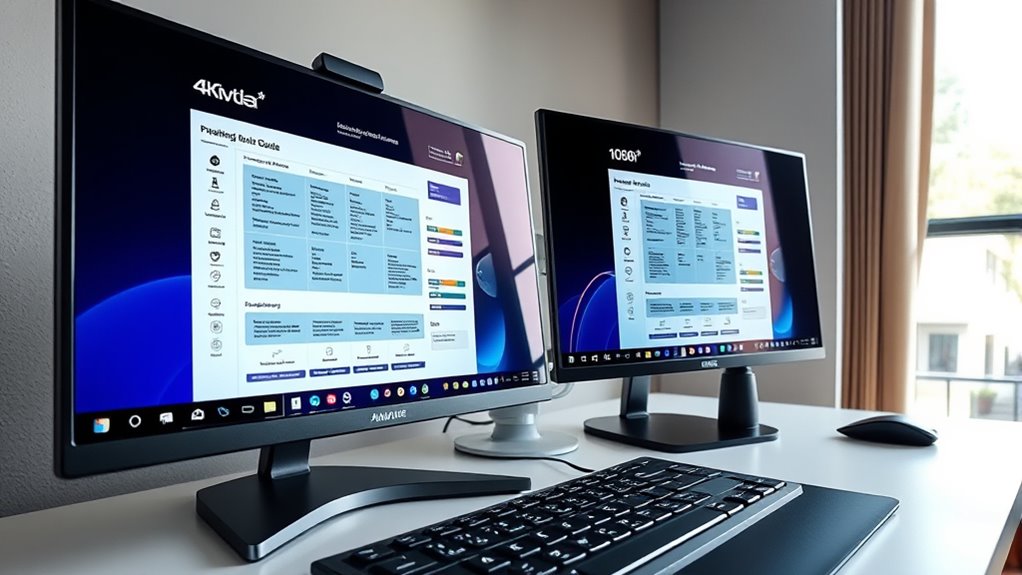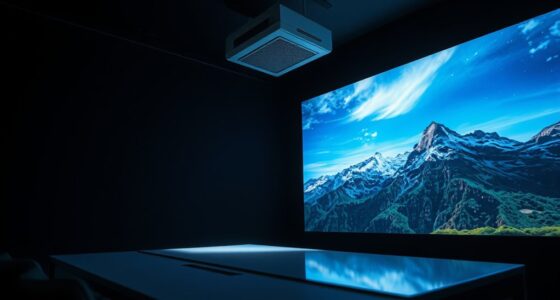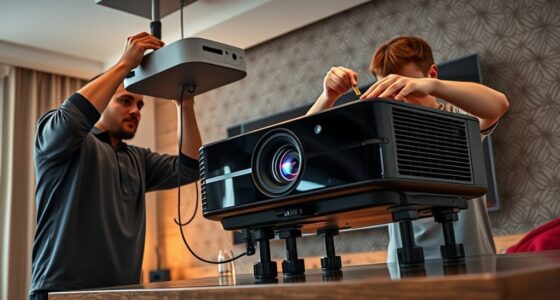To avoid common mistakes when comparing 4K and 1080P setups, consider your screen size, viewing distance, and content quality before upgrading. Don’t assume higher resolution means better experience—check hardware compatibility and aim for proper calibration. Budget for extra equipment and consider ambient lighting to enhance picture quality. Assess your actual needs and usage patterns carefully. Keep these factors in mind, and you’ll be better equipped to make the right choice—more insights await if you continue exploring.
Key Takeaways
- Assess your screen size and viewing distance to determine if 4K resolution offers a noticeable benefit over 1080P.
- Ensure your devices and cables support the required HDMI or DisplayPort standards for optimal 4K or 1080P performance.
- Evaluate source material quality; higher resolution is ineffective if content is low quality or heavily compressed.
- Consider environmental factors like ambient lighting and room size, which can diminish the perceived advantages of higher resolution.
- Balance resolution upgrades with budget, setup complexity, and actual usage needs to avoid unnecessary spending and over-investment.
Overestimating the Benefits of Higher Resolution
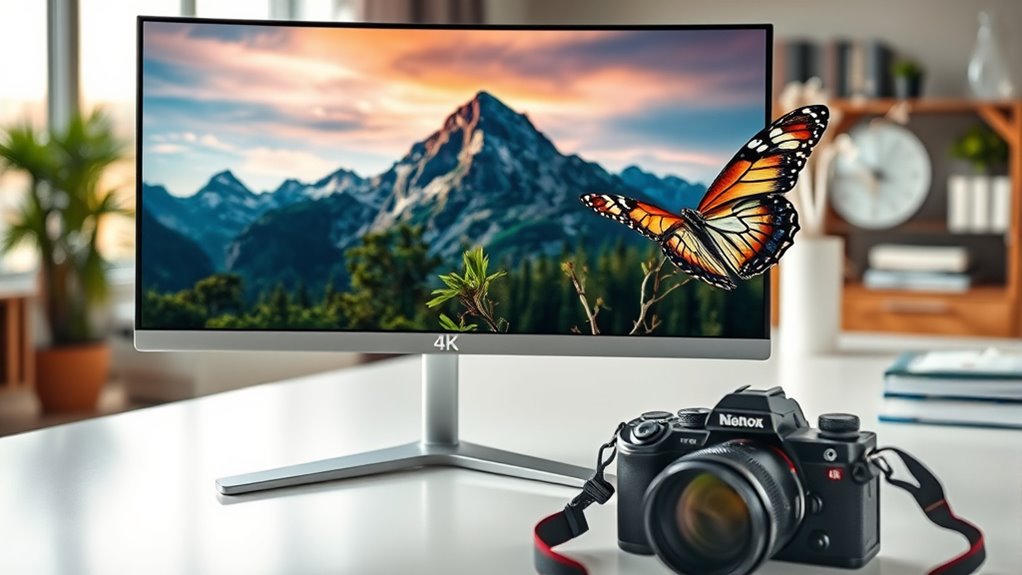
Many people assume that higher resolution automatically means a better viewing experience, but that’s not always true. Resolution myths often lead you to believe that more pixels guarantee perfect picture quality, but pixel perfection isn’t everything. Higher resolution can reveal more detail, yet it doesn’t automatically improve image quality if the source material or display isn’t up to par. You might think 4K is always superior to 1080P, but in reality, the difference depends on factors like screen size and viewing distance. Overestimating the benefits of higher resolution can cause you to overlook more important aspects like contrast, color accuracy, or content quality. Remember, a higher pixel count doesn’t always translate into a better experience if other display elements aren’t optimized. Additionally, understanding how bedroom design elements influence overall ambiance can help you create a more comfortable and visually appealing space.
Ignoring Screen Size and Viewing Distance
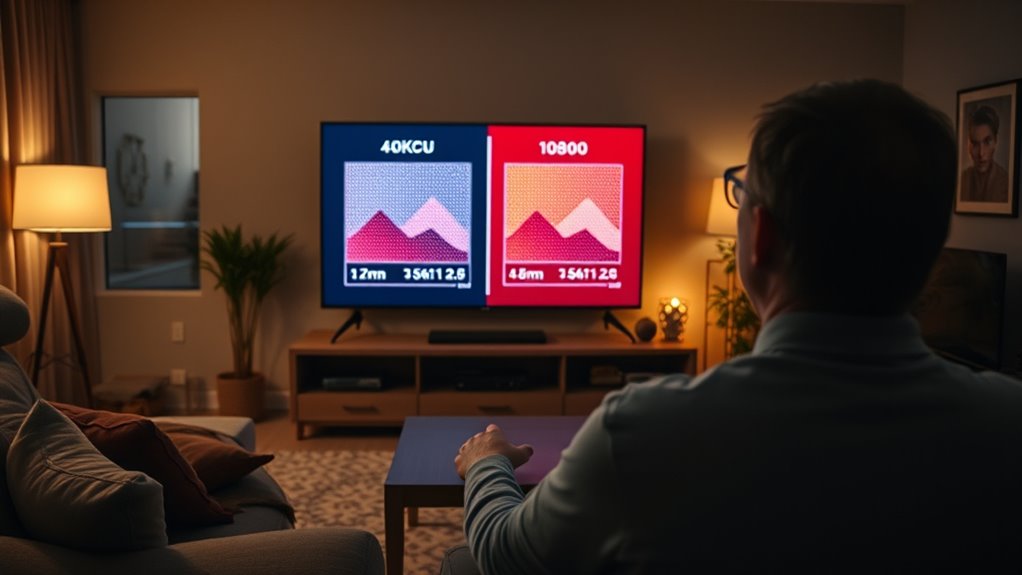
When choosing between 4K and 1080P, overlooking your screen size and viewing distance can lead to wasted effort and subpar viewing experiences. Screen size considerations are essential because a larger screen benefits more from higher resolutions like 4K, which enhances detail and clarity. Conversely, with smaller screens, the difference between 4K and 1080P may be negligible. Viewing distance importance also plays a role; sitting too close to a large screen makes lower resolutions more noticeable, while sitting farther away diminishes the need for 4K. Ignoring these factors can result in over-investing in unnecessary resolution or missing out on ideal picture quality. Always assess your space and how far you’ll sit from the screen to make the most informed resolution choice.
Choosing Based Solely on Resolution Without Considering Content Quality

Focusing solely on resolution can lead you to overlook the actual quality of the content you’re watching. Higher content resolution doesn’t always mean better picture quality if the source material is poor or compressed. For example, 4K content with low bitrate can look worse than high-quality 1080P footage. It’s crucial to consider the overall content resolution and how it impacts picture quality, not just the pixel count. Sometimes, a lower resolution with higher bit depth or better compression offers sharper, clearer images. Ignoring this can result in choosing a display that doesn’t enhance your viewing experience. Always evaluate the source material’s quality and how it translates to your display before making resolution your primary decision factor. Additionally, considering the content quality and the type of media can significantly influence your viewing satisfaction.
Neglecting Hardware Compatibility and Connectivity
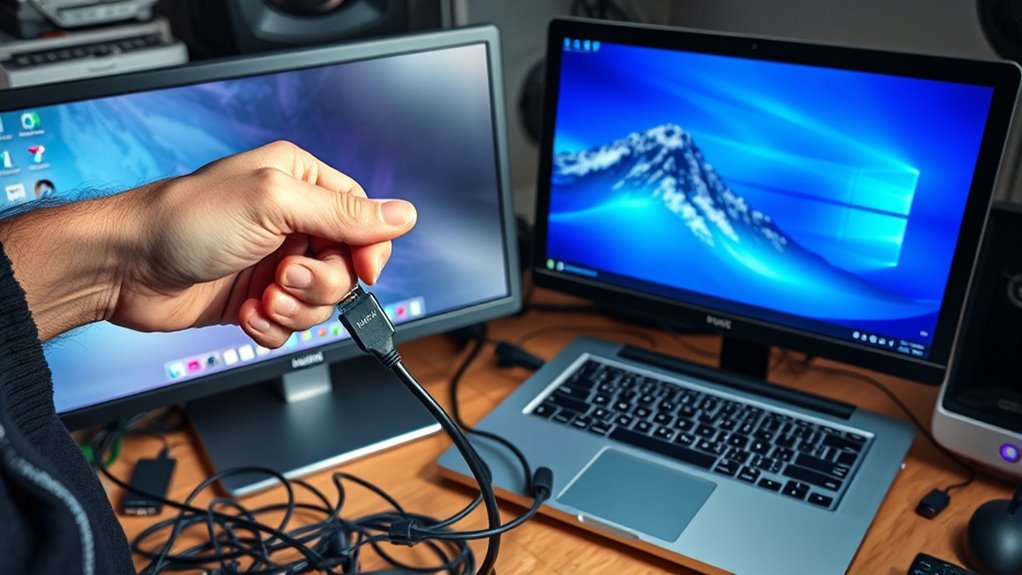
Make sure your devices have compatible ports for 4K or 1080p signals, like HDMI 2.0 or DisplayPort 1.4. Check if your equipment supports the resolution you want to avoid connection issues. If you overlook this, you might end up with a mismatch that limits your viewing experience. Additionally, understanding the Audi Tuning options available can help optimize your system’s performance and compatibility.
Check Port Compatibility
Ever wondered if your devices can handle the display resolution you want? Checking port compatibility is essential for guaranteeing smooth device connectivity. Not all HDMI, DisplayPort, or USB-C ports support 4K or 1080p at the desired refresh rates. For example, older HDMI ports might only support up to 1080p, limiting your options. Verify your device’s port specifications before purchasing cables or monitors. Using incompatible ports can lead to poor image quality or no connection at all. Also, make certain your graphics card and display both support the resolution and refresh rate you aim for. Failing to check port compatibility can cause frustration and hardware limitations. Take a moment to confirm your device connectivity options to avoid surprises and get the best viewing experience. Additionally, understanding port specifications can help you determine whether your hardware supports the desired resolution and refresh rate.
Ensure Device Support
To enjoy the full benefits of 4K or 1080p displays, you need to guarantee your device actually supports the hardware requirements. Ignoring device specifications can lead to compatibility issues, preventing you from experiencing ideal picture quality.
Check these key points:
- Make certain your device’s hardware, like GPU and CPU, can handle the resolution you want.
- Verify that your cables and ports support the necessary bandwidth for 4K or 1080p signals.
- Confirm your device’s firmware is up to date to avoid compatibility issues with new display standards.
- Ensure your device’s refresh rate aligns with your gaming or viewing preferences for smooth performance.
Underestimating the Importance of HDR and Color Accuracy

While resolution often takes the spotlight, overlooking the significance of HDR and color accuracy can severely diminish your viewing experience. HDR calibration enhances contrast and brightness, making images more lifelike and detailed. Ignoring this step means missing out on vibrant colors and deep blacks that truly bring content to life. Additionally, poor color grading can lead to dull, inaccurate visuals that don’t match the creator’s intent. When you underestimate these factors, you risk settling for a picture that feels flat or washed out, regardless of resolution quality. Ensuring proper HDR calibration and paying attention to color accuracy are essential for a true cinematic experience. Creativity can be applied to adjusting display settings to better match your viewing environment, leading to a more immersive experience. Don’t overlook these elements—they’re key to maximizing your display’s potential and enjoying content as intended.
Failing to Budget for Additional Equipment and Setup Costs
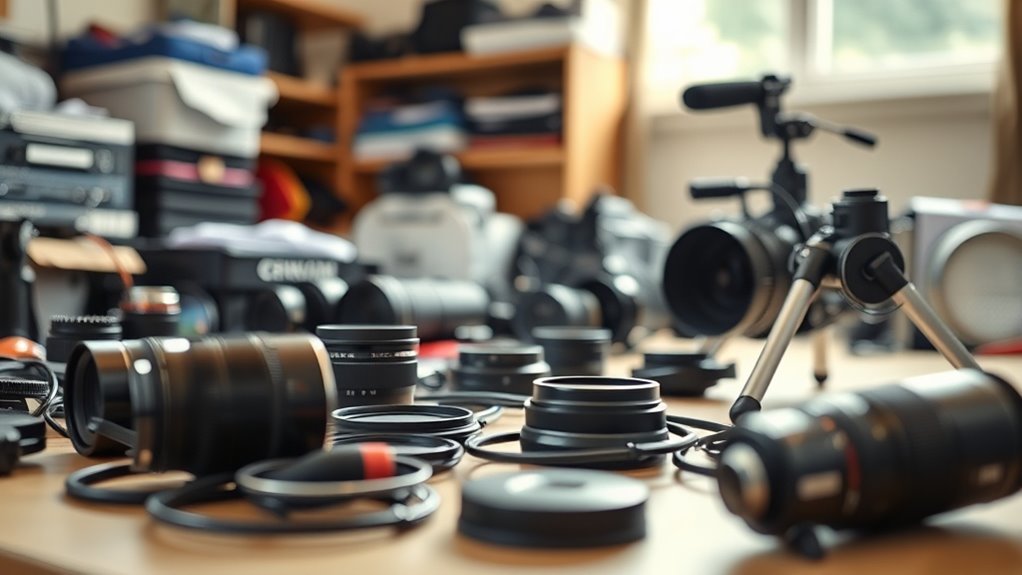
Overlooking the costs associated with additional equipment and setup can lead to unexpected expenses that undermine your entire viewing upgrade. Proper budget planning is essential to account for all equipment costs. Failing to do so might leave you short when it’s time to purchase necessary accessories or professional installation. Additionally, considering aviation-themed apparel or accessories can enhance your viewing experience by creating a more immersive environment.
Misjudging Your Actual Viewing Needs and Usage Patterns
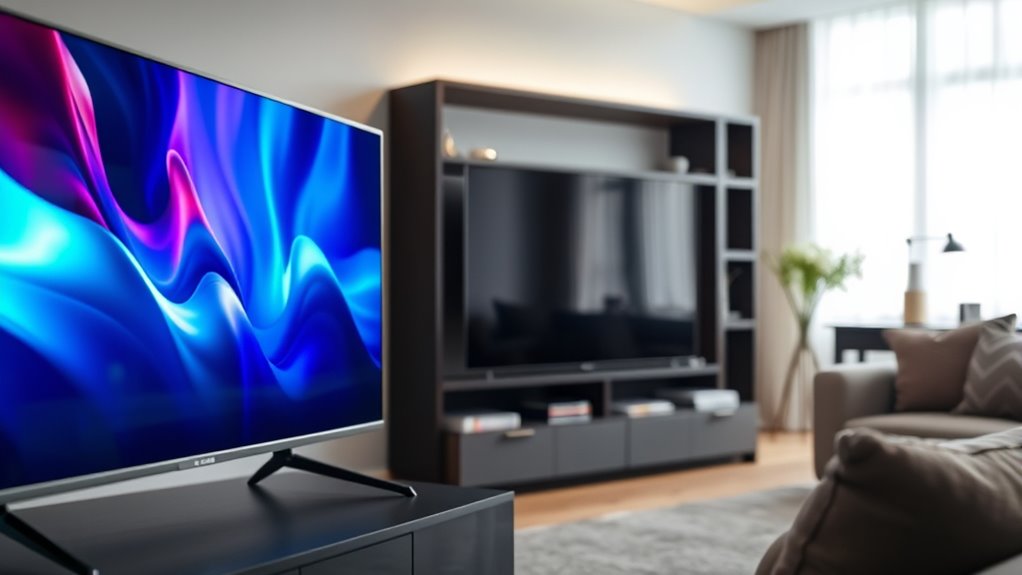
To choose the right resolution, you need to understand how you typically watch content and in what environment. Think about whether you mostly stream movies, play games, or browse online, and if your space is small or large. Making these assessments helps you avoid overspending on features you won’t use. Additionally, consider security vulnerabilities in new technologies to ensure your devices and network stay protected.
Assess Typical Content Types
Understanding the types of content you typically watch can prevent you from overestimating your display needs. By evaluating your viewing habits, you can better tailor your setup for ideal content customization and user preferences.
Ask yourself:
- Do you mainly stream movies and shows in high resolution, or do you watch casual videos and gaming content?
- Are you focused on detailed visuals, like nature documentaries, or do you prioritize fast-paced action?
- Do you often watch on larger screens, or do you prefer smaller displays for casual use?
Knowing these factors helps determine if 4K’s enhanced clarity is necessary or if 1080P suffices. This clarity ensures your display aligns with your actual content needs, avoiding unnecessary upgrades and enhancing your viewing experience.
Consider Viewing Environment
Your viewing environment plays a significant role in determining whether a 4K or 1080P setup makes sense for you. Consider the ambient lighting in your room—bright lights or sunlight can wash out the picture quality, making high resolution less noticeable. If your space has lots of natural light, a high-quality 1080P TV might suffice, or you may need to invest in better screen coatings or curtains. Room acoustics also matter; if your room has poor sound quality or echoes, upgrading your audio setup could be more beneficial than focusing solely on resolution. A well-placed, acoustically optimized environment enhances overall viewing experience, regardless of TV resolution. Understanding these factors helps you choose the right display and setup, avoiding unnecessary upgrades and maximizing your viewing pleasure.
Frequently Asked Questions
How Does Ambient Lighting Affect 4K Vs 1080P Viewing?
Ambient lighting substantially impacts your viewing contrast, especially when comparing 4K and 1080p. Bright ambient light can wash out images, reducing detail and making it harder to enjoy the depth of 4K resolution. In darker rooms, 4K TVs shine by delivering richer contrast and clarity. To optimize your experience, control ambient light levels, especially for 4K content, and use proper curtains or lighting to enhance contrast and picture quality.
Can I Upgrade My Existing TV to 4K Easily?
You can upgrade your TV to 4K easily, as most modern models are designed for simple compatibility. Over 80% of recent TVs support 4K resolution, making the shift smoother. Check your upgrade compatibility and TV connectivity options first—many 4K models connect via HDMI, which you probably already have. Upgrading is straightforward; just make certain your devices support 4K to enjoy sharper, more vibrant visuals effortlessly.
What Are the Energy Consumption Differences Between 4K and 1080P TVS?
You’ll find that 4K TVs generally have similar or slightly higher power consumption compared to 1080p models, but their energy efficiency depends on size and technology. Modern 4K TVs often use LED backlighting, which can be energy-efficient. To save power, look for models with good energy efficiency ratings. Keep in mind that larger screens tend to use more power regardless of resolution, so choose wisely based on your energy consumption needs.
Is There a Significant Difference in Streaming Bandwidth for 4K Content?
Think of streaming 4K content as trying to fit a waterfall through a garden hose. Yes, there’s a significant difference in bandwidth requirements; 4K demands much more bandwidth than 1080p. This affects streaming quality, making it sharper and more detailed when your internet can handle it. If your bandwidth is limited, you might experience buffering or lower quality, so make certain your connection can support that high-resolution splash.
How Do 4K and 1080P Impact Gaming Performance?
When gaming in 4K versus 1080p, you’ll notice resolution benefits like sharper visuals and enhanced display clarity, making gameplay more immersive. However, 4K demands more from your GPU, potentially reducing frame rates and impacting performance if your hardware isn’t powerful enough. With 1080p, you get smoother gameplay and less strain on your system. Choose 4K for stunning visuals, but guarantee your setup can handle the increased processing load.
Conclusion
Think of choosing between 4K and 1080p like picking the right pair of shoes—you don’t need the biggest, most expensive pair if they don’t fit your needs. I once bought a 4K TV thinking it’d transform my movie nights, but it sat unused because I overlooked my viewing space and content quality. Avoid these mistakes, and you’ll find the perfect fit for your setup, making every viewing moment clear and enjoyable.
